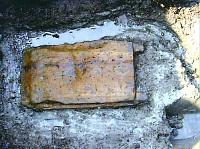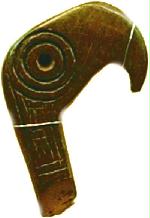
The Ningbo Institute of Cultural Relics and Archaeology
announced this month that, after a 4-month excavation of 725 square
meters, they have confirmed the discovery of a 7,000-year-old
village of the early Hemudu culture.
The site is at Fujiashan in the Jiangbei District of Ningbo
City, in the eastern province of Zhejiang.
 According to a specialist from the institute,
the site is one of the largest-scale, highest-yield and
best-preserved sites in the province after the Hemudu site itself. According to a specialist from the institute,
the site is one of the largest-scale, highest-yield and
best-preserved sites in the province after the Hemudu site itself.
The relics excavated showed it to be a Neolithic site in the
early stage of Hemudu culture, which involved cultivation, fishing,
hunting and gathering.
Chu Xiaobo, the institute's deputy head, said the Fujiashan site
is 20 kilometers from the Hemudu site and 5-6 kilometers from the
recently discovered Tianluoshan site, which belongs to the same
culture. The position of the three sites indicates that the
Yaojiang River may have been the home of the Hemudu culture.
 The Fujiashan site was
wood-based, facing east and with Fujia Mountain to its west. It's
more than 30 meters wide and 16 meters deep. Wares have been found
that were constructed using slots and pairs of tenons -- the first
time these have been found in the Hemudu culture. The Fujiashan site was
wood-based, facing east and with Fujia Mountain to its west. It's
more than 30 meters wide and 16 meters deep. Wares have been found
that were constructed using slots and pairs of tenons -- the first
time these have been found in the Hemudu culture.  Archeologists said the
inhabitants built houses and settled down as their lifestyle
shifted from hunting animals to planting vegetables, raising
livestock and making handicrafts. Archeologists said the
inhabitants built houses and settled down as their lifestyle
shifted from hunting animals to planting vegetables, raising
livestock and making handicrafts.
They found many fragments of charcoal, connected with the marks
made by fire on the top and surface of crossbeams, suggesting that
it may have been fire that destroyed the village eventually.
 Wu Xiangdong, the head of
the institute, said they had unearthed a large number of relics.
The most numerous were earthenware -- recoverable items totaled
more than 470 -- and some were first examples in Hemudu culture, as
were the patterns engraved onto them. Wu Xiangdong, the head of
the institute, said they had unearthed a large number of relics.
The most numerous were earthenware -- recoverable items totaled
more than 470 -- and some were first examples in Hemudu culture, as
were the patterns engraved onto them.
Among the relics, the most delicate and vivid was an
eagle-head-shaped piece of ivory, chiseled on both front and back.
The eagle's beak is hook-shaped and its eyes wide open, giving it a
fierce and powerful countenance.
Another eagle-shaped earthenware item was also recovered, in the
form of a bird spreading its wings, and was another first time
discovery for this period. Archeologists conjectured that it may
have been used in sacrifices.
 Another interesting find was
a pot full of cooked water chestnuts. The archaeologists speculated
that it might have been abandoned after a sudden disaster, such as
a flood, fire, or an attack from wild animals or enemies. Another interesting find was
a pot full of cooked water chestnuts. The archaeologists speculated
that it might have been abandoned after a sudden disaster, such as
a flood, fire, or an attack from wild animals or enemies.
(China.org.cn by Chen Lin, January 25, 2004)
|

